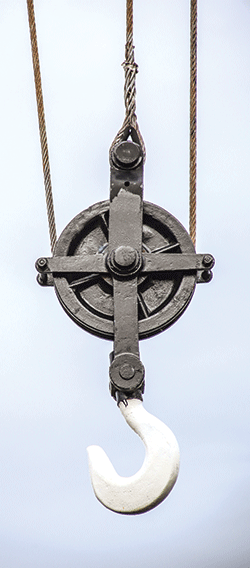

Wire ropes are hard-working components in many different applications, from mines to lifts, ports, construction sites and drainage systems. Ron Byrnes, senior technical sales representative and wire rope specialist at Lubrication Engineers (LE) South Africa says that the correct lubrication of wire ropes is absolutely critical, as wire ropes are more than just cables. They are intricate machines, composed of interdependent parts in constant motion. Wear takes place, not only between the wires, but also in the strands as a result of the linear movement within the rope.
Without lubrication, the insides of a wire rope will corrode. Byrnes says that corrosion does not automatically equate to rust. It is also the loss in steel or steel area within the rope as the rope components scuff and fret against each other. Correct lubrication can significantly reduce this wear, extending the safe and useful service life of the rope. “Rust corrosion is equally important, but more often we see internal wear in a rope, which is very difficult to contain, and without lubricant, it is in fact impossible,” he adds.
Improving general wire rope lubrication practices
He continues that at many sites and in various applications, the lubrication of wire ropes can be quite hit or miss. Operational teams mostly keep an eye on their ropes and lubricate these when they think it’s needed. Teams are only able to really assess the state of a rope and the amount of lubrication required when running a non-destructive electromechanical test.
Byrnes advocates for an application theory approach to the lubrication of wire ropes. This includes two key aspects of understanding the rope. The first is how it works, what function it plays in a particular application and how it moves. The second is how the lubricant works with that movement within the rope to diminish the effects of wear and corrosion.
The South African context
In South Africa, there are both locally manufactured and imported wire ropes in operation, and these have different construction and rope designs. The lubricant that is applied to a rope at the time of manufacture also differs. In South Africa, usually a bitumen-based lubricant is used. Bitumen is a coating grease that has to be heated before application due to its consistency. When heated, it can be poured onto a rope through a funnel.
In terms of how this affects the approach to lubrication once a wire rope is in use, Byrnes says that it is important to have a lubricant that can work successfully for the rope, regardless of the type of lubricant applied at the point of rope manufacture. “We can’t obviously change what manufacturers do, but what we are looking for is a perfect fit, a match from our product offering that complements what is done during rope manufacturing,” he says.
He recommends LE’s Wirelife Monolec Penetrating Lubricant 2001, which has a Timken OK load rating of 27,2 kg, and diluent additive to enhance the penetration of the lubricant into the rope interstices. It is ideal for imported, high performance compacted wire rope, and also LE’s Wirelife Almasol Coating Grease 452, which is NGLI 00 grade, for round, non-spin and 6-stranded triangular ropes. This provides a lubricant that is fluid enough to be massaged between the outer strands and into the core of the rope using a Viper rope lubricator.
A Viper rope lubricator is a collar with seals that is strapped down and held in place so a rope can move through it. A wire rope cleaner can be attached to the front of the system, which spins against the rope as it moves through it, removing old lubricant and cleaning it. Then fresh lubricant is applied as it moves through the Viper rope lubricator.
Even on ropes that have previously had a bitumen-based lubricant applied, the Wirelife Almasol Coating Grease 452 won’t fling off. In sub-zero conditions, bitumen-based lubricants become hard and brittle and fling off the rope, which causes damage. However, Wirelife Almasol Coating Grease 452 functions effectively in a wide range of temperatures from -20 to 120°C.
Environmental benefits
Environmental impact is another critical aspect of rope lubrication. Bitumen-based lubricants, when exposed to fire, release toxic fumes that pose significant health risks. In contrast, LE’s products are designed to meet stringent safety and environmental standards, with high flashpoints and reduced emission of harmful substances during combustion.
For more information contact Lubrication Engineers,

© Technews Publishing (Pty) Ltd | All Rights Reserved